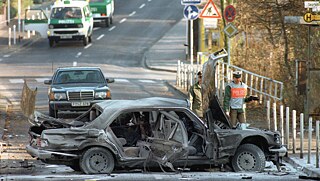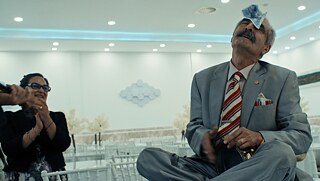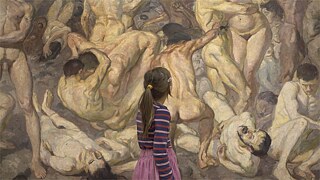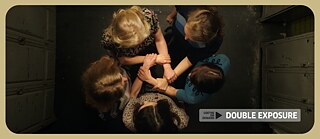"Double Exposure" is a project of the Goethe-Instituts of North America that deals with questions of solidarity that transcend identitarian, national, ethnic and linguistic boundaries. With this film series, we would like to turn our attention to ambiguity, consonance and dissonance as well as to what belongs together in what is different.
Double or multiple exposure is a photography technique in which two or more individual shots are superimposed to form a single image. –Unlike photomontage, in which superimposed motifs are opaque, this transparent layering allows each motif to appear as translucent, creating a new meaning. Each superimposed image retainstraces of its original context, so not only do two motifs merge and overlap, but so do their contexts of origin. This interplay creates something new –the images enrich each other –though details of the individual images may also be superimposed, faded, or neutralized.Double Exposure is a project of the Goethe-Institut North America that explores questions of solidarity, specifically a form ofsolidarity that transcends identitary, national, ethnic and linguistic boundaries without ignoring or rejecting them. What constitutes a society based on solidarity? Is there a right to solidarity? Is solidarity a duty? To whom is solidarity practiced?
The term “solidarity” has Latin and French roots and means ‘togetherness’. Based on the photographic context established above, solidarity should be understood as a concept of interference, where superimposition is a fundamental element. In an increasingly complex world, in which we are more globally connected than ever before, in which online images of environmental disasters and war crimes are followed by TikTok compilations of adorable cat videos, the focus here is explicitly on simultaneity and complexity.
The film series aims to consciously explore and address polycontexturality (where all phenomena exist simultaneously in different, often contradictory contexts) and intersectionality (where each phenomenon represents an intersection of characteristics that can reinforce or weaken on another). In contrast to anti-solidarity tendencies, social divisions, and simplistic messages of salvation from right-wing conservative populists on both sides of the Atlantic, this seriesfocuseshere is on ambiguity, consonance and dissonance, as well as on what belongs together in what is different.
Simultaneities and historical superimpositions

Still from “Trümmermädchen”: After years of patiently suffering male aggression, the young women (Anna Gesa- Raija Lappe, Lena Urzendowsky, Lara Feith, Katja Hutko) fight back. | © Artkeim2 / UCM.ONE
Oliver Kracht's Trümmermädchen - Die Geschichte der Charlotte Schumann (2021), a punky, furious and deliberately anachronistic examination of Germany in the “zero hour” from a feminist perspective, takes a bold, contemporary, and deconstructive look at the German post-war period. The aim is not only to examinethe generation that built and supported the two German states and whose canon of values still resonates today, but also to pose highly topical questions about patriarchal power structures and to envision radical solutions.
► Click here to watch the film now (free)

Still from "Black Box BRD" | © zero one film
In his documentary Black Box BRD (2001), Andres Veiel contrasts two men who could not be more different: On the one side is Alfred Herrhausen, one of the most powerful men in Germany in the 1980s as CEO of Deutsche Bank, who died in a bomb attack in 1989, and on the other Wolfgang Grams, a member of the terrorist organization Rote Armee Fraktion. Veiel's search for clues leads him back to the involvement of the Germans in National Socialism and the early history of the Federal Republic of Germany. Both figures, Alfred Herrhausen and Wolfgang Grams, exemplify two opposing life paths, whose contrasting circumstances and trajectories are re-examined.
► Click here to watch the film now (free)
Equal tones and assonances

Still from “Symphony of Now” | © Symphony of Now
What image do we have of Berlin, and to what extent is our own experience influenced by the images we see of the city in advertising campaigns and on social networks? What exactly is subculture, and how can the music of migrant workers that originated in Germany be integrated into the country's musical history? Drawing inspiration from Walter Ruttmann'sBerlin, the Symphony of a Metropolis (1927), Johannes Schaff's Symphony of Now (2018) presents a contemporary kaleidoscope of Berlin at its peak as the international capital of hedonism some 90 years later. Carried by a dynamic soundtrack (including Frank Wiedemann, Modeselektor, Hans-Joachim Roedelius), the film is about a prototypical iconization of metropolitan evening and nightlife in all its facets in a series of vignettes edited in quick succession. The film celebrates the simultaneity of high culture and the underground with carefree ease.
► Click here to watch the film now (free)

Still from "Liebe, D-Mark und Tod" | © filmfaust Production
The recruitment agreement with Turkey in 1961 brought not only guest workers to Germany but also their music. Cem Kaya's dense documentary essay Love, Deutschmark and Death (2022) is a tutoring session in Turkish-German contemporary history: assembly line jobs, homesickness, and family reunification. Her music developed independently from German mainstream society, consistently supported by the Turkish community and responsive to its needs.
► Click here to watch the film now (free)
Revisiting the "Denkmal"

Still from “Friendship Of Men” | © Rosa von Praunheim Filmproduktion
Was Goethe perhaps gay? Did Heinrich Heine lay the foundation for socially accepted homophobia with his public criticism of fellow poet August Graf von Platen? Why are there so many pictures of naked women in museums, but hardly any depictions by female artists? And what if Jesus had been a woman or a non-binary person?

Still from "Girls / Museum" | © Shelly Silver
Shelly Silver explores these questions in an entertaining way in her documentary Girls/Museum (2020), and Rosa von Praunheim in his experimental documentary Friendship of Men (Männerfreundschaften) (2018). Neither filmmaker is afraid to question our so-called national “monuments” – our Goethes and Schillers, our Dürers and Cranachs – in a curious and probing way.
► Click here to watch Girls/Museum now (free)
► Click here to watch Friendship of Men now (free)
